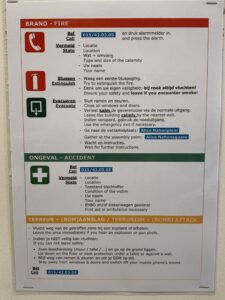
Evacuate, hide, fight: What to do in case of an active shooter
While it seems to be an American phenomenon, Belgium has known its school shooting scares as well. Even just last week, when a 17-year-old brought a weapon to school in Sint-Niklaas. Hopefully, you’ll never need it, but what should you do in case of an active shooter?
Last Thursday, a 17-year-old student came to school with a firearm in their backpack. Another student saw the weapon and notified the school, who then notified the police. The 17-year-old has been admitted to a psych ward while the investigation continues.
Profile of an active shooter
The Belgian student hadn’t drawn his weapon at school so he doesn’t qualify as an active shooter. But what is an active shooter, then?
In a leaflet, Victim Support Europe defines an active shooter as ‘someone who uses firearms to hurt or kill people in a confined or open space’. They also go on to say that active shooters are unpredictable and often have no target, so everyone is at risk.
What YOU can do
Homeland Security created a 13-page booklet about what to do and how to behave or act in case of an active shooter. Homeland Security is the American federal executive department for public safety. On their website, they state that active shooter incidents escalate quickly and evolve rapidly. Therefore, it is important that one knows what to do if they end up in a such a delicate situation.
- Evacuate
If possible, evacuate. Get yourself away from the shooter. Locate the nearest (emergency) exits and leave the premises. Homeland Security has listed a number of things to keep in mind when evacuating during a shooting. The most important ones are:
- Have an escape route and plan in mind. Make sure you know where you’re going and how you’re going to get there. No aimlessly running around in search of a way out.
- Leave your belongings behind. Don’t try to carry your stuff with you, it will only slow you down. You’ll need your hands and full focus to escape.
- Keep your hands visible. When you exit the building, keep your hands where officers can see them so they don’t mistake you for the shooter.
- Hide out
If evacuating is not possible, seek shelter and find a place to hide from the shooter. In this case, Homeland Security prescribes some qualities a hiding place must comply to, being:
- Your hiding place should be out of the shooter’s view.
- Your hiding place should provide protection in case shots are fired in your direction. This could be a closed door that separates the room you’re in from where the shooter is.
- Your hiding place shouldn’t trap you or restrict your options for movement. This means, don’t hide in a small closet.
- Take action
If all else fails or is not possible, try to fight back. But only as a last resort and if your life is in imminent danger, try to disrupt or incapacitate the shooter. According to Homeland Security, this can be done by:
- Acting as aggressively as possible against the shooter.
- Throwing items at the shooter and improvising weapons.
- Yelling.
It is also important to note that you should only call emergency services if it is safe for you to do so. In case of an active shooter, always put your phone on silent or do not disturb so it cannot give away your position if it were to ring.
Belgian schools
In Belgium, school shootings happen considerably less than in the United States of America. That is mostly because the law around guns here in Belgium is much stricter than in the US. In Belgian schools, there are protocols for emergency situations.
In Thomas More, for example, there is a flyer with an evacuation plan in every room. The evacuation plan covers three possible threats: fire, accidents or terrorism. That plan describes what to do in the different emergency situations to help you survive them.
Text: ©Elise-Charlotte Kindts
Image: © Felipe Jiménez (via Pexels)





